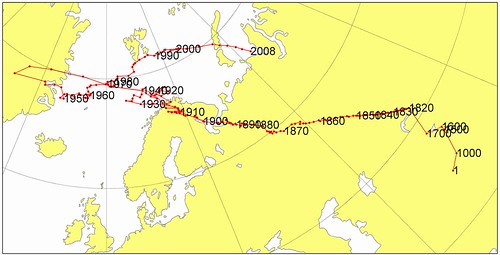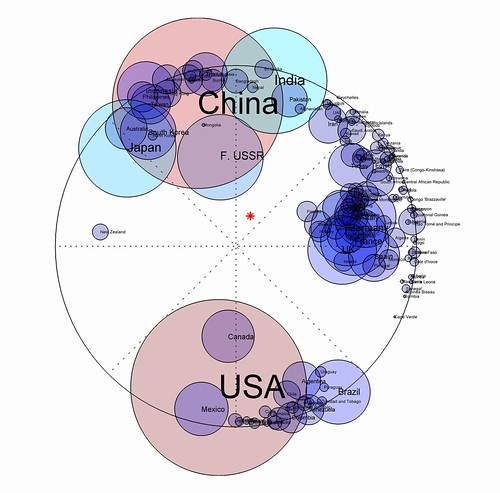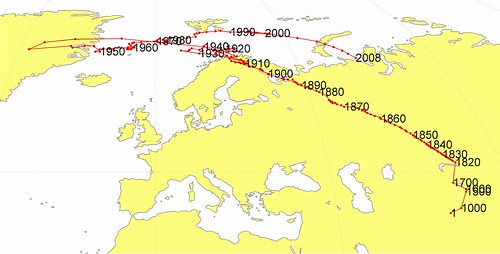April 15, 2011
Why Bayadaratskaya Bay is the center of the world
I came across the paper The Global Economy’s Shifting Centre of Gravity by Danny Quah (Global Policy Volume 2 Issue 1 January 2011), which has a neat plot of the "centre of gravity" of the world economy 1980-2007. Since I happened to have Angus Maddison's historical GDP data at hand I decided to go a bit further back and replicate the paper's findings.
The "centre of gravity" is defined as the GDP-weighted average location of economic activity. Quah used large cities, I just used the geographic coordinates for individual countries (i.e. I assumed the economy was evenly distributed, which is of course not true). This point is inside the Earth, and I projected it to the nearest surface point.
Quah did a cylindrical projection since he was more interested in the longitude behaviour; hence I end up much further north than him. If you consider the US, China and Europe as seen from above the North Pole, it is not hard to see that the centre ends up somewhere in the Arctic.
Around 1 AD the centre of gravity was dominated by the Roman empire, India and China, hovering somewhere in the neighbourhood of Northern Pakistan. By 1000 Rome was not doing well, and the centre moved east and north. Gradually Europe woke up, in 1700 the centre passes lake Vsyk-Köl in Kyrgyzan and around 1800 Lake Bajkal. Then a smooth move towards the Northwest begins, bringing the centre to the White Sea in 1900. The US starts to grow like crazy, dragging the centre westwards (with a few pirouettes in the Norwegian Sea due to the great depression and world wars), reaching the top of Greenland in 1945. And now East Asia and especially China are dragging it east again, reaching the Siberian coast in 2008.
It is of course debatable what we actually learn from this. Quah's paper mainly seems to aim at showing that in the future much of the economy is going to be in India and China, something which is obvious to anybody who has read the forecasts. Maybe the centre of gravity is a good way of visualizing it, but I have my doubts - it is not a natural object. The whole exercise reminds me of how a few municipalities in Sweden are competing about being the geographical centre of the country (or the demographical center, or the most easily accessible, or...) The fact that the arrangement of other, remote things place a special point here doesn't make the pointed to location particularly important.
My favourite line in the paper is this:
(In future, with ongoing scientific progress, locations for economic activity might be off the Earth’s surface – whether above or below – so that the last equality would then no longer hold. However, nothing essential changes in the calculations.)
Very true. But hopefully it will be possible to add a gift shop to the centre of the world economy.
Posted by Anders3 at April 15, 2011 03:50 PM

